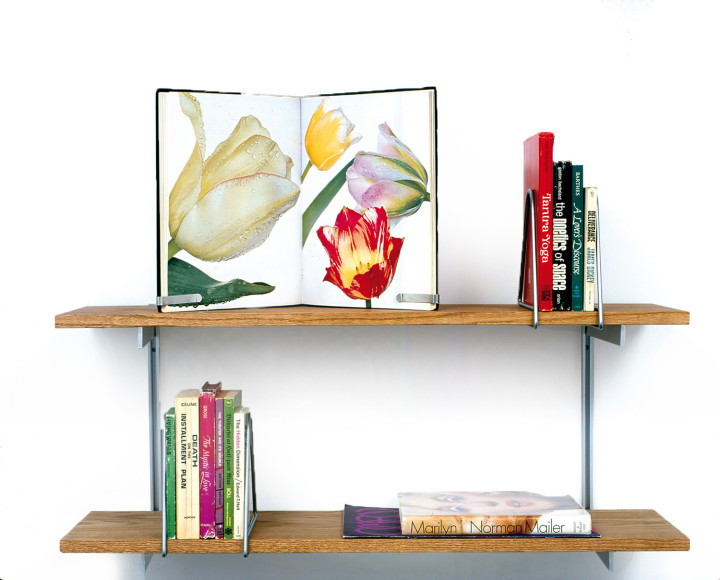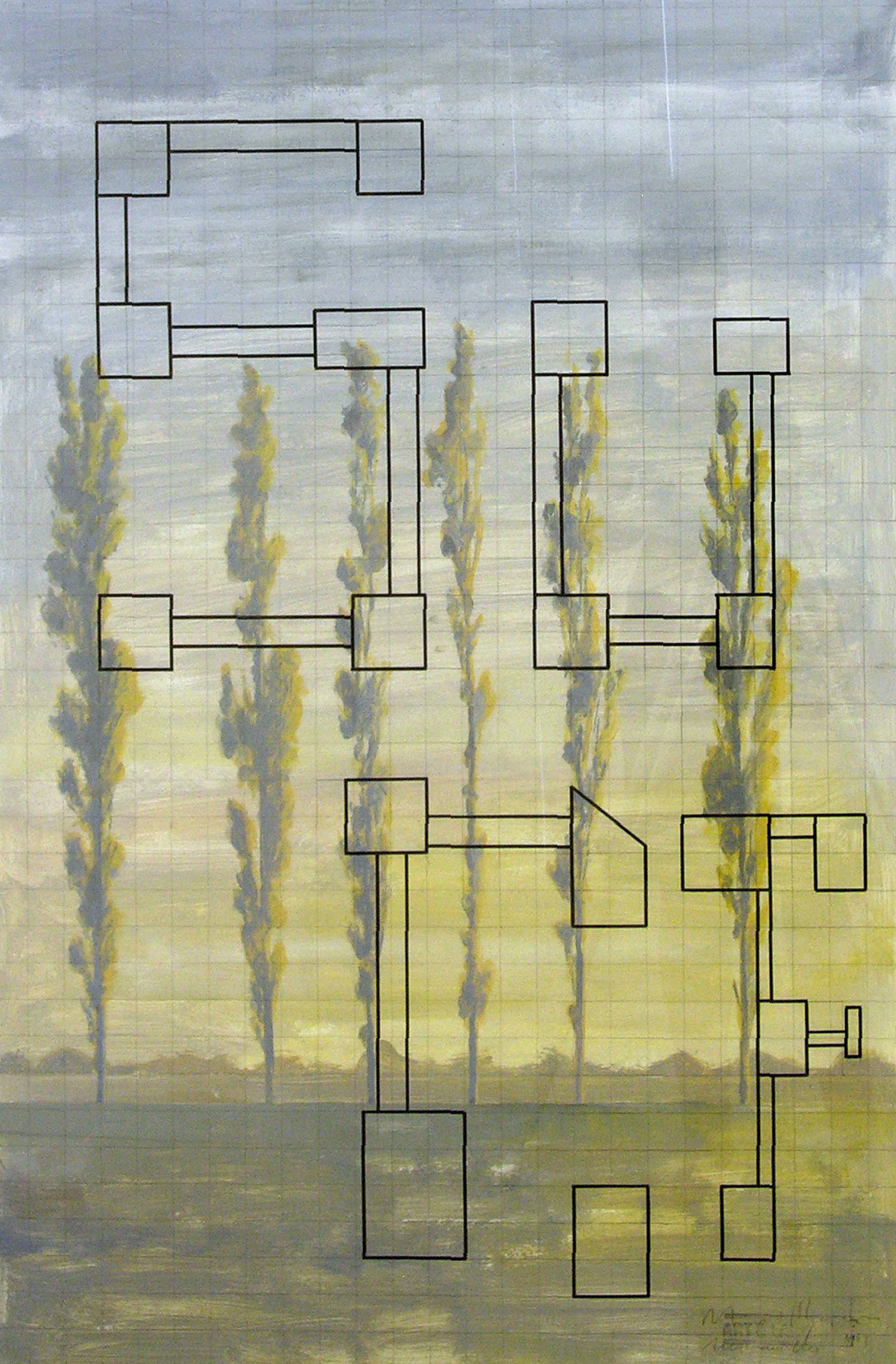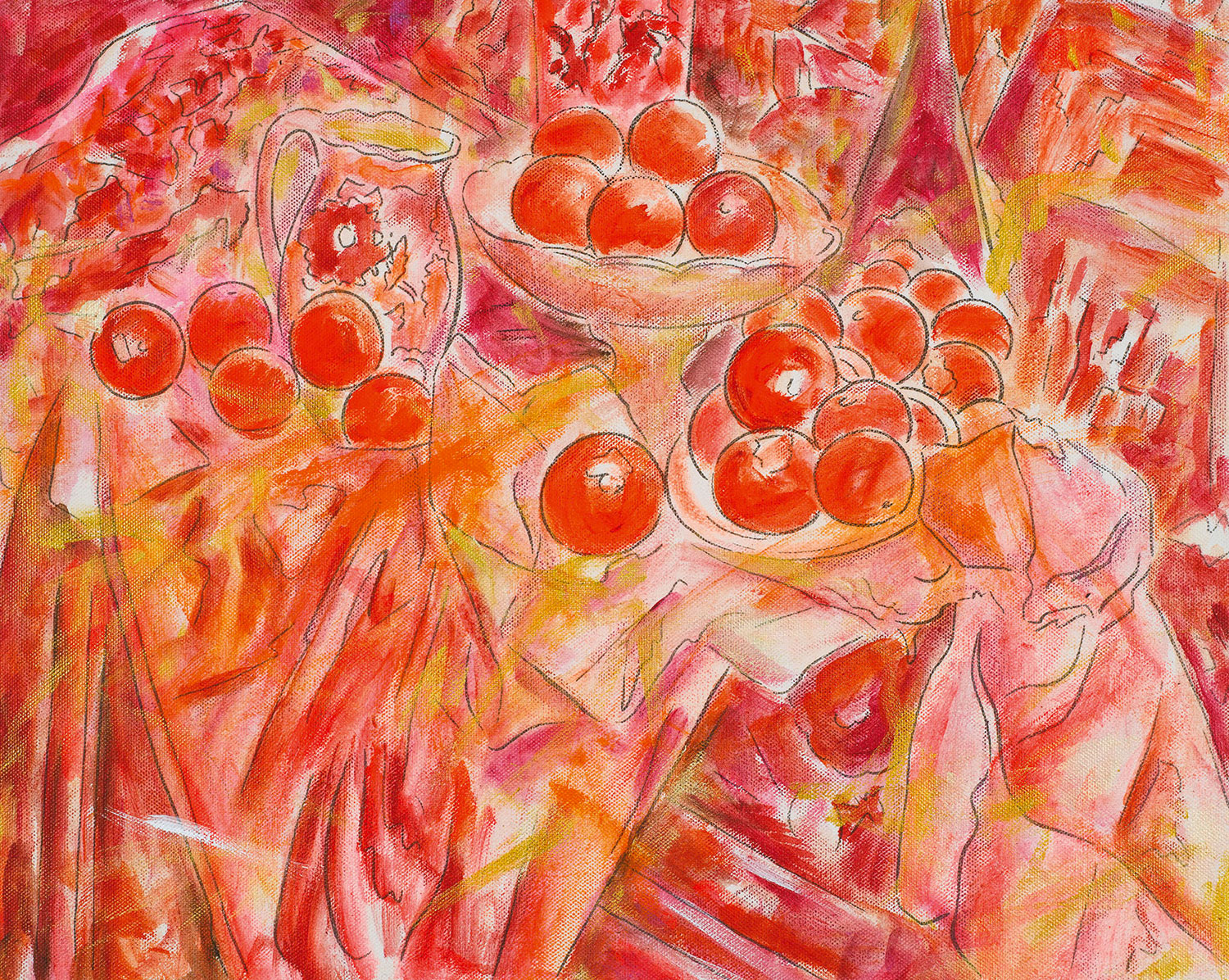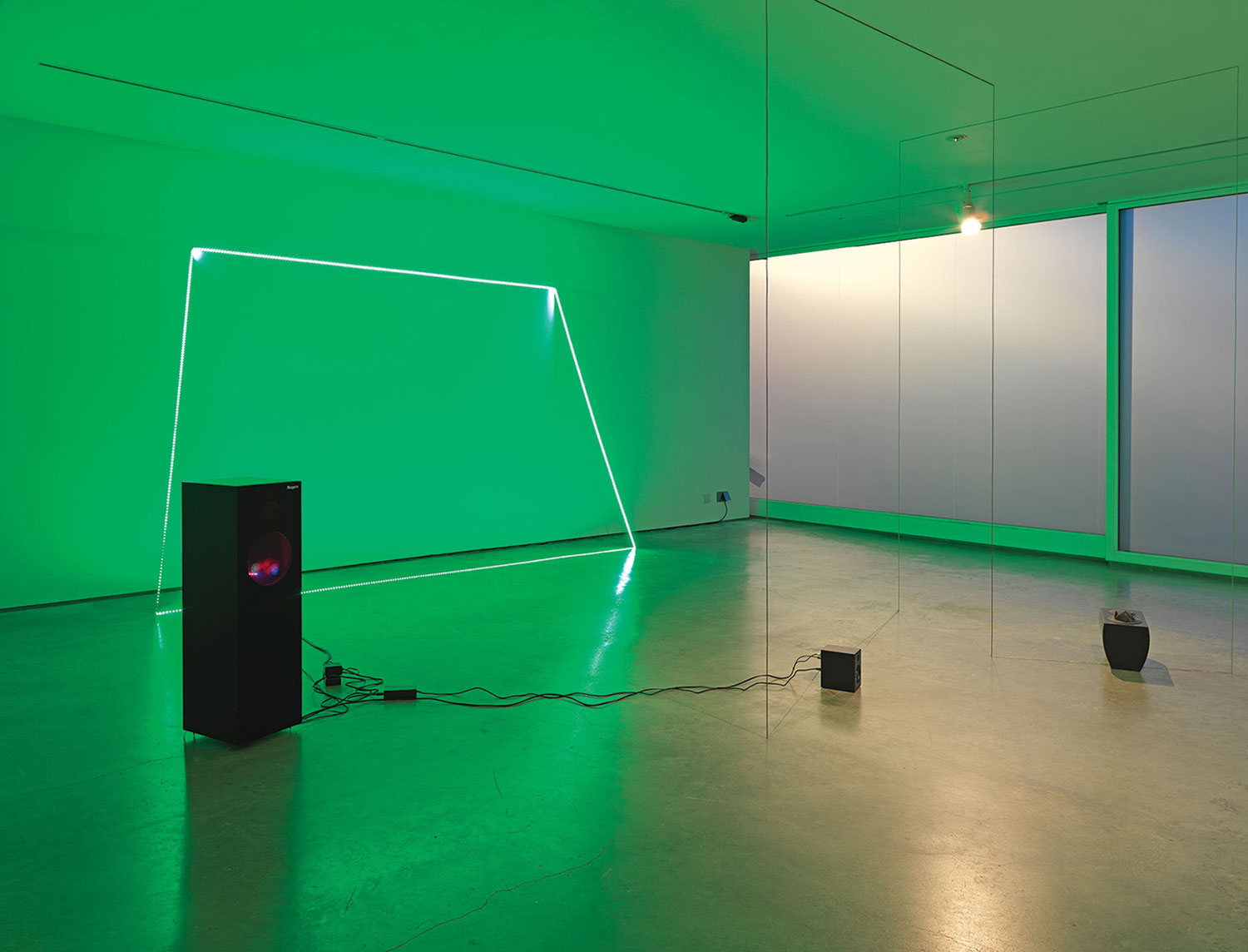
Carol Bove: The editor who commissioned this conversation suggested we might talk about modernism, but I’m not really thinking about modernism anymore, or anyway not particularly.
Steven Claydon: I have similar misgivings about modernism and what is expected of one’s practice. I was trying to figure out my own brief flirtation with the idea and realized it provided an expedient vessel from which to address a wider set of issues. I was thinking about your work and it seems to me that your relationship with modernism was very autobiographical and reflected a particular set of impressions from growing up in Berkeley during a kind of swan-song period in modernism. I like that you mentioned science fiction, as the genre fulfills a similar role for me, considering a future projection as cherished memory. I find it puzzling that science fiction can sometimes assume a role of actualized experience for people. Expectations of the future can also influence industry and policy.
I have been trying to wrestle with the notion of “material fidelity,” something distinct from truth to materials, and I suppose a notion that also allows for a kind of “material infidelity” or even treachery with the things one makes. What do you think in relation to your work?
CB: I like the idea of material infidelity or treachery. The feeling from the word ‘treachery’ rings with some of the dark tones in your work. I played with the dialectic of authenticity and fraudulence for a while, which is either the same problem or one with a lot of attachment points. I couldn’t define authentic art without cornering myself and eventually I got exhausted from the chase. Fraudulence is a little easier to approach. You can’t talk about “truth in materials” because it’s unfashionable, and besides, that discussion comes with a lot of historical baggage. Or simply said, it’s a historical idea. Doesn’t the understanding that materials are already heavily implicated take part in “material fidelity”?
SC: Authenticity and truth is an impossible territory and, as you said, consigned to history. We could, however, contemplate the potential of art catalyzing an original encounter. I think certain thinkers were referring to this when they talk about truth and authenticity. I am also more reconciled to the artwork as a sort of prop or vehicle for the suspension of disbelief. Could you ever see that as a useful way of considering your own work?
CB: Your use of the word ‘prop’ leads me to alternating images of your work, first as a makeshift scaffold in relation to a human form and then as a stage-bound object that is the most succinct expression of an alternate reality. One of my great attractions to becoming a cultivated art viewer is the practice I get in taking mutually exclusive positions. To be concrete I would mention The Oracle, a sculpture I made earlier this year. With a sculpture like that I think about corporate lobby art, a Roman bust, a Brancusi, the display of fragmented antiquities at the Metropolitan Museum and shells as interior design motifs.
SC: The Oracle was, for me, the defining piece in your show at Kimmerich last year in New York. I have for a long time considered this a-parallel approach to be the only appropriate way to construe my own things as that is how I perceive others. I see it as a climate of these discrete properties and narrative trajectories that describe an orbit around an errant core. Joseph Conrad talked about narrative in a similar way when he refers to the “yarns of seamen.” Conrad likens a tale to a nut; the story weaves itself around its subject to form a shell that smothers the kernel and never refers directly to it but recalls the kernel by allusion.

CB: Conrad’s nut is such a good image for what you’re doing. I wanted to recall the conversation we had a few years ago, concerning assistant use, etc. I’ve been asking myself, is this the kind of artist I want to be, i.e., somebody who runs a small production shop? I had more of an image of taking mushrooms in a cave in North Africa when this vocation hailed me.
SC: Believe me, I would love to accommodate some of that beatnik stuff again, but once you get started, expedience dictates that you have a responsibility to your profession that often precludes hedonism.
CB: I often feel I’m neglecting my responsibility to the world through my wanton capitulation to market demands. And that’s not to set practical considerations at odds with a romantic ideal, but accepting the market as part of the world that the work inhabits. Not incidental, but essential to the objects themselves. I think about working into the primitive zone of commerce, appealing to the desire to consume and possess as a way to set ideas loose into the world. It’s a little perverted. But then it’s the perverted feeling that makes it seem interesting, and I go back in the shop instead of working on something less tangible. Part of “material fidelity” is bringing together combinations of materials, which might be matter but might also take the form of shapes or finishes, to arouse a feeling of inappropriate sexuality. The materials need to have integrity as individual elements to aggregate with erotic effect. And unfortunately “expensive looking” is one of the tones that turns me on.
SC: I’d like to pick up on your thoughts concerning the role of seduction, surface, etc. There is a danger of importing or appropriating fully fledged material with the aesthetic intact, and I can think of a number of artists who are in the curious position of being seduced by the subject matter they set out to critique. Having said that, there is something vital in sailing too close to the spectacle and entertaining the specter of style. There are multiple aspect ratios at play here. I think I can detect these strategies at play in your work. I see no contradiction in combining wistful or poetic notions of transformation with a more removed, academic or less esoteric position.

CB: I’m interested in critique and seduction — that is certainly part of it. Why bother working with materials you don’t care about? I think my incorporation of hubris is about critique and seduction. For reasons unknown to me I was drawn again and again to Philip Johnson situations. Those explorations were sort of like a flirtation with an older man — I admired him but at the same time found him adorable and ridiculous. The specter of style sounds appealingly sinister, and I’m all for style generally because I don’t consider it a superficial addition to a thing, but more that the outward aspect is expressing the inner meaning. We are both using these evaporated pedestal forms. Mine are all straight rectangular prisms but yours sometimes have more complicated faceting. What are those forms?
SC: The more complex pedestals were a reference to the Pythagorean cult. Comprising twelve facets, they describe a dodecahedron. We naturally assume that mathematics has a bias toward logic and explication, but to the Pythagoreans it was very different. They saw it as unraveling a mystic code for the Divine plan. This newly deduced information was deemed to be so potent and potentially destructive in the wrong hands that certain equations were suppressed and only revealed to initiates. The most powerful of these equations being the dodecahedron. I am interested in pre-ethical/pre-Socratic philosophy for its amazing invention, speculation and compound nature. Having said all of that, the dodecahedron was a concurrent component of the work but not a concluding definition. I was interested in what you were saying about how one can subtly alter a material through our own conception. Subjectivity has a very strong influence over the status of material and visa-versa. That is for me the vacillation between what Heidegger described as the ‘earth’ and the ‘world’ of a thing.
CB: Have you read Moby Dick?
SC: Yes, that book is an inexhaustible mine of material; It’s as diffuse, layered, simple and complex as zoo-plankton, phytoplankton, krill and other unwilling creatures filtering through the baleen plates of a great cetacean. I get bleary eyed just watching Jaws. Anything maritime has a quasi-religious effect on me. As Ian Hamilton Finlay once said, “Who couldn’t love boats?” I think you could genuinely read that book backwards or rearrange the chapters and construe the narrative by smell. How much do you think that your maritime location in Red Hook [a neighborhood in Brooklyn, New York] has influenced your work, and to what extent should one allow outside or local influence into a practice?
CB: I really like this question because it’s gotten me thinking about… how to put it? Accepting something suspicious about my artwork. Sometimes I’ve thought that my interest in the ’60s is some version of identity politics, like the worst part of identity politics that would reduce whatever you make to your demographic. It’s confining and deterministic. My living near the water now or my growing up in Berkeley in the ’70s is all part of a larger event. It seems correct that my experience is what my work is going to be made of.
SC: There are a few artists that I have met from an early age through chance encounters, establishing mixed relationships with their work. My wavering opinions have subsequently effected my development as an artist; an experience most artists confront, I’m sure. It goes back to the notion of autobiography in partnership with historical perspective and research. One of these artists, Charles Simonds, I had the pleasure to meet after I curated a show that included a one-off piece. I started to think that perhaps there was some kind of voodoo conspiracy at work with Charles’s work. I would discover Charles Simonds catalogues wherever I went and often in the most unlikely places; sun bleached by the Seine or staring at me in a thrift store or palace. That kind of relationship with an artist’s work could not have developed in a more academic, retrospective way.

CB: Normally you invent objects based on… based on what? For myself I apply this ethos of non-invention, so that what I’m doing with objects is more like framing. Even when I’m inventing, like physically sculpting material into a form that didn’t exist before, I think of it as non-invention because the forms feel familiar. What you are doing is similar, but not exactly the same.
SC: In the second chapter of Guignol’s Band (1944) by Louis-Ferdinand Céline, the author casually makes an allusion to an area of London’s East End called Trom, somewhere near Whitechapel. It is a totally fictitious place, an invention. The bell project sprang from a kind of revelry inspired by the heterogeneous nature of the East End of London. Céline describes the constant booming of Big Ben highlighting the underlying violent change inherent in the city. This stirred up my childhood vision of the docklands of London as an endless bombsite. I tried to imagine where Trom might be; Trom for me was and is in the area directly under St. Paul’s Church, Bow Common. The external bell and frame bother me. Exposed like balls peeping from swimming trunks. Semi-secular. Trom bell is a real question mark. I elaborated and stitched the bell into a number of scenarios as an obscure motif for disorientation. The amnesiac bell: autonomous, self-questioning and obsolete. Self-ringing, an alarm clock with no time zone or ritual application, rung by the random events that set up temporary orbit around it. Scoop it up with the rest of the silly signifiers. Melt it down! Make it suffer.
CB: I think I smell the plot! This is your material in/fidelity and your narrative. Atmosphere. Like some fertile substance that can accumulate, like orgone* but sometimes dusty orgone.
SC: At one point we were discussing certain forms of magic that require an appropriated item from the subject of a spell to increase the efficacy. Sometimes these would be treated (Duchamp’s assisted ready-made) or buried under the floor of the unwitting target. What do you think?
CB: I have had some funny experiences that make me think they’re spells.





